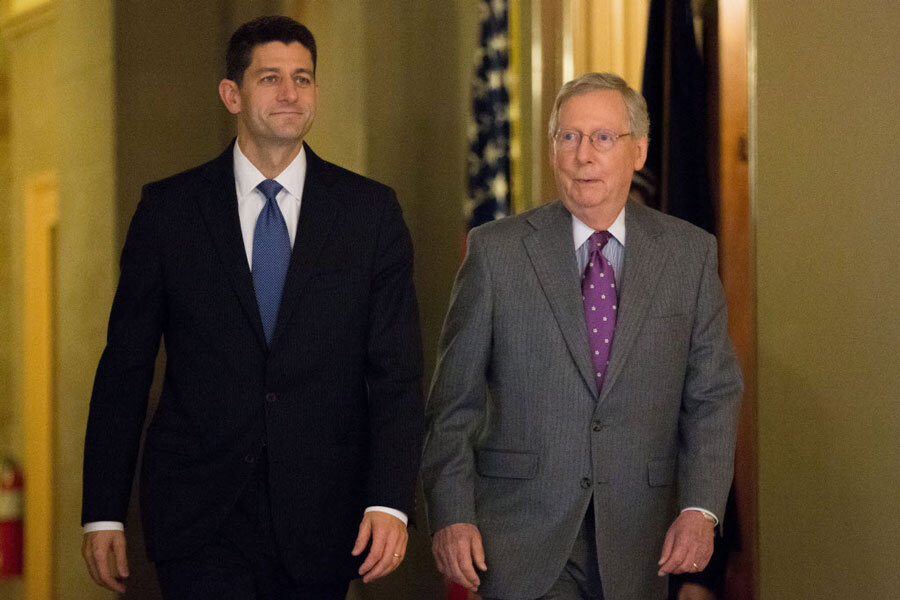Federal deficits are back, big time. Here's what D.C. can do.
Loading...
| Washington
The era of falling deficits is over, and America’s fiscal future looks grimmer than expected, the nonpartisan Congressional Budget Office reported on Tuesday.
It’s a wakeup call for a nation that has turned its focus away from the issue in recent years. It raises questions about whether Washington can address the rising deficit without resorting to the brinkmanship that created debt-ceiling crises and resulted in an almost universally reviled budget sequester.
This year, for the first time since 2009, the budget deficit will increase – to $544 billion, up by $105 billion from last year, according to the government report. The reason is mostly because of tax cuts and spending increases that Congress passed last year, but also because of expected slower economic growth and some technical issues.
Longer term, annual federal deficits will total $9.4 trillion over a decade – $1.5 trillion more than expected, the CBO reports.
The report concerned budget-watchers.
“What jumped out at me more than anything else, is that the level of debt held by the public is growing rapidly,” says G. William Hoagland, senior vice president of the Bipartisan Policy Center. In a decade, it’s projected to be $24 trillion – an increase of $10 trillion from today.
At a time when the average voter has “heard nothing in the campaign debates … on the debt,” it demands Washington to “focus,” Mr. Hoagland says.
How did we get here?
The United States has had declining deficits since the Great Recession high of $1.4 trillion in 2009. The economy started growing again and a record number of jobs were created, so revenues increased. It also helped that the Federal Reserve kept interest rates low, making debt repayment cheaper.
That removed some pressure on Congress. But the conservative House Freedom Caucus might be willing to reapply pressure in light of the new report. Even last week, caucus chairman Rep. Jim Jordan (R) of Ohio told the Monitor that the caucus has “a lot of concerns” about the agreed-on, bipartisan budget levels for 2017.
How do we get out?
Much was made of the bipartisan “sequester,” or budget caps, that the White House and Congress agreed to in 2011. But that was the wrong place to look for savings, says Hoagland. The sequester dealt with “discretionary” spending such as military and education. What needs addressing is mandatory spending – on Social Security, Medicare, Medicaid – which is a much bigger part of the budget.
But in 2012, when Rep. Paul Ryan (R) of Wisconsin proposed turning Medicare into a voucher system, Democrats released a “granny” ad, which depicted a Ryan look-alike pushing an elderly woman in a wheelchair over a cliff. It was politically devastating for Republicans.
Ryan said on Fox News Sunday that House Republicans will deal with entitlement reform in their 2016 agenda. Matt Mackowiak, a GOP consultant, says such a plan would have a better chance of succeeding with a Republican in the White House.
Where do we go from here?
Even if Republicans take the White House, views within the party differ, Mr. Mackowiak, points out. “Budget hawks, fiscal hawks, realists – there just are too many threads here,” he says.
Moreover, the parties also differ on how to reduce the deficit. “Until Republicans are willing to close tax loopholes that benefit the wealthy and well connected for the purpose of deficit reduction, they have no credibility speaking about the deficit,” Rep. Chris Van Hollen (D) of Maryland said in a statement to the Monitor.
But Democrats, too, differ on spending issues. Presidential candidate Sen. Bernie Sanders (I) of Vermont is calling for “Medicare for all,” or a “single payer plan,” to replace Obamacare. That’s an expensive proposition, which he says can be paid for with higher taxes. Hillary Clinton, meanwhile, wants to fix the Affordable Care Act, not replace it.
Still, the CBO report offers an opportunity to get the issue of debt and deficits back out in front of the public, said Michael Peterson, president of the Peterson Foundation, a nonprofit focused on America’s fiscal challenges.
He said in a statement: “The 2016 election is an important opportunity for a national conversation, as voters across the country are calling on candidates to put forward their plans to secure America’s fiscal and economic future.”






